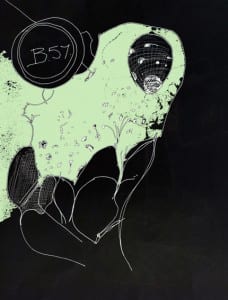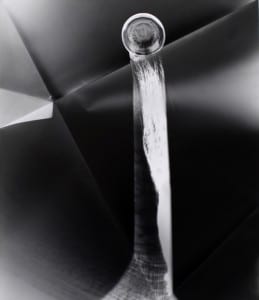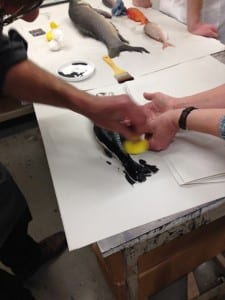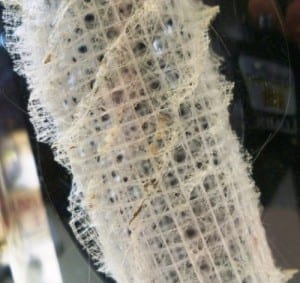
Frontispiece of Johann Becher’s Physica Subterranea.
‘Man, like all animals, is glass and can return to glass’ writes the German alchemist Johann Becher in his work Physica Subterranea published in 1669. Becher claimed that he had found the secret of turning dead bodies into transparent glass, so that we could surround ourselves with beautiful vases formed of our ancestors (preferable, he writes, to ‘hideous and disgusting cadavers’).
The glass of each animal and plant has its own particular colour – that of plants is green, while glass made from humans, he writes, is a milky white colour with ‘a slight tinge of narcissus’.
Becher, unfortunately, was wrong. Trace amounts of silicon, the element that is used in forming glass,* do exist in the human body through our diet (beer is one particularly good source) and may improve the health of bones – but it’s unclear exactly how it does this, or whether it’s biologically essential.** However, this hasn’t stopped a proliferation of claims for the benefits of silica supplements to make our teeth, hair, nails and skin stronger and more glassily beautiful.
Silicon is essential to some plants and animals, though, in particular those erose earlier in the evolution of life such as glass sponges, which use silica to grow their interlocking needle-like spicules.
As artist in residence here at the Grant Museum I’ve been focusing on the sponge collection and the ways in which a material can be both organic and inorganic – combining to form both a living animal and a glass jar. One aspect that particularly interests me is the history of humans believing that they are made of glass, a belief which spread amongst European scholars during the 15th to 17th century.
For Johann Becher, this fueled his desire to create glass vases from dead bodies. For others, however, it was a debilitating disorder known as ‘The Glass Delusion’. Sufferers believed that they were made from glass and would shatter at just one touch. It mainly afflicted wealthy men, and the most famous sufferer was perhaps King Charles VI of France who believed himself made entirely from glass and wore protective clothing to prevent being smashed to pieces.
For other sufferers it was mainly their head or buttocks that concerned them, so they avoided sitting down, or always carried a soft cushion. Why this belief spread during this period is unclear, but it had disappeared by the end of the 17th century, coinciding with the gradual replacement of alchemy with the emergence of modern chemistry.
However, as the current interest in silica supplements suggests, it seems there’s still a belief that glass may combine with and enhance the human body – not to shatter us, but to make us glow with a glassy transparency.
Image source: ‘The Magic and Myth of Alchemy’, Lloyd Library and Museum, 2011. www.lloydlibrary.org/exhibits/alchemy/alchemists.html. Accessed 12.12.2014.
* Silicon is an element that likes to share – in particular with oxygen. Rather than existing in its pure state, it tends to gives away or share its electrons with other elements, and this creates compounds. One of these compounds is silica, also known as silicon dioxide, which exists in sand – this is the stuff that is used to create glass.
** See R. Jugdaohsingh, ‘Silicon and bone health’, Journal of Nutritional Health and Aging. 11(2), Mar-Apr, 2007. 99-110.
Eleanor Morgan is Artist in Residence at the Grant Museum of Zoology
 Close
Close









